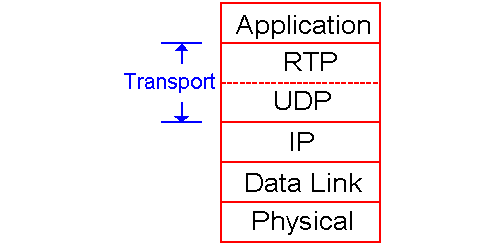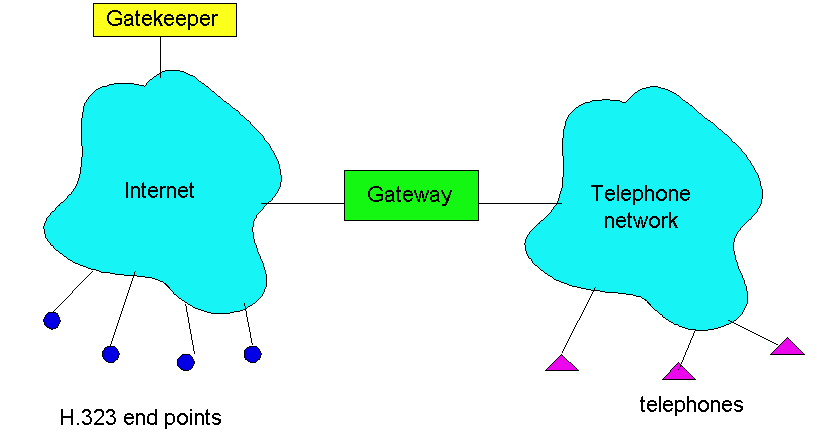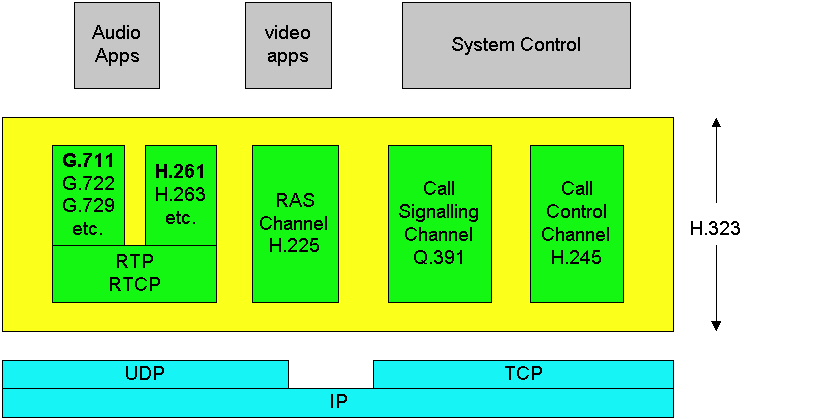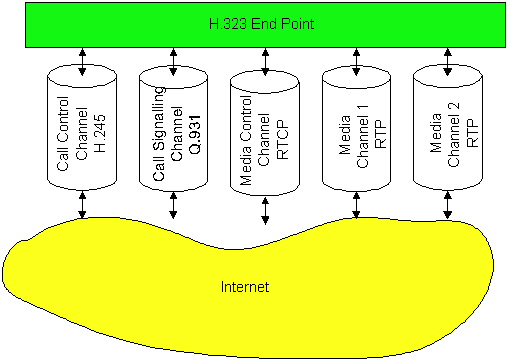
Figure 6.4-1 RTP can be viewed as a sublayer of the transport
layer.
In this section we attempt to provide a readable introduction to RTP and to its companion protocol, RTCP. We also discuss the role of RTP in the H.323 standard for real-time interactive audio and video conferencing. The reader is encouraged to visit Henning Schulzrinne's RTP site [Schulzrinne 1997], which provides a wealth of information on the subject. Also, readers may want to visit the Free Phone site, which describes an Internet phone application that uses RTP.

Figure 6.4-1 RTP can be viewed as a sublayer of the transport
layer.
From the application developer's perspective, however, RTP is not part of the transport layer but instead part of the application layer. This is because the developer must integrate RTP into the application. Specifically, for the sender side of the application, the developer must write code into the application which creates the RTP encapsulating packets; the application then sends the RTP packets into a UDP socket interface. Similarly, at the receiver side of the application, the RTP packets enter the application through a UDP socket interface; the developer therefore must write code into the application that extracts the media chunks from the RTP packets. This is illustrated in Figure 6.4-2.
As an example consider using RTP to transport voice. Suppose the voice source is PCM encoded (i.e., sampled, quantized, and digitized) at 64 kbps. Further suppose that the application collects the encoded data in 20 msec chunks, i.e, 160 bytes in a chunk. The application precedes each chunk of the audio data with an RTP header, which includes the type of audio encoding, a sequence number and a timestamp. The audio chunk along with the RTP header form the RTP packet. The RTP packet is then sent into the UDP socket interface, where it is encapsulated in a UDP packet. At the receiver side, the application receives the RTP packet from its socket interface. The application extracts the audio chunk from the RTP packet, and uses the header fields of the RTP packet to properly decode and playback the audio chunk.
If an application incorporates RTP -- instead of a proprietary scheme to provide payload type, sequence numbers or timestamps -- then the application will more easily interoperate with other networking applications. For example, if two different companies develop Internet phone software and they both incorporate RTP into their product, there may be some hope that a user using one of the Internet phone products will be able to communicate with a user using the other Internet phone product. At the end of this section we shall see that RTP has been incorporated into an important part of an Internet telephony standard.
It should be emphasized that RTP in itself does not provide any mechanism to ensure timely delivery of data or provide other quality of service guarantees; it does not even guarantee delivery of packets or prevent out-of-order delivery of packets. Indeed, RTP encapsulation is only seen at the end systems -- it is not seen by intermediate routers. Routers do not distinguish between IP datagrams that carry RTP packets and IP datagrams that don't.
RTP allows each source (for example, a camera or a microphone) to be assigned its own independent RTP stream of packets. For example, for a videoconference between two participants, four RTP streams could be opened: two streams for transmitting the audio (one in each direction) and two streams for the video (again, one in each direction). However, many popular encoding techniques -- including MPEG1 and MPEG2 -- bundle the audio and video into a single stream during the encoding process. When the audio and video are bundled by the encoder, then only one RTP stream is generated in each direction.
RTP packets are not limited to unicast applications. They can also be sent over one-to-many and many-to-many multicast trees. For a many-to-many multicast session, all of the senders and sources in the session typically send their RTP streams into the same multicast tree with the same multicast address. RTP multicast streams belonging together, such as audio and video streams emanating from multiple senders in a videoconference application, belong to an RTP session.

Payload Type Field
The payload type field in the RTP packet is seven-bits long. Thus 27
or 128 different payload types can be supported by RTP. For an audio
stream, the payload type field is used to indicate the type of audio encoding
(e.g., PCM, adaptive delta modulation, linear predictive encoding) that
is being used. If a sender decides to change the encoding in the middle
of a session, the sender can inform the receiver of the change through
this payload type field. The sender may want to change the encoding
in order to increase the audio quality or to decrease the RTP stream bit
rate. Figure 6.4-4 lists some of the audio payload types currently supported
by RTP.
|
|
|
|
|
|
|
|
|
|
|
|
|
|
|
|
|
|
|
|
|
|
|
|
|
|
|
|
|
|
|
|
|
|
|
|
|
|
|
|
Figure 6.4-4 Some audio payload types supported by RTP.
For a video stream the payload type can be used to indicate the type
of video encoding (e.g., motion JPEG, MPEG1, MPEG2, H.231). Again, the
sender can change video encoding on-the-fly during a session. Figure 6.4-5
lists some of the video payload types currently supported by RTP.
|
|
|
|
|
|
|
|
|
|
|
|
|
|
|
Sequence Number Field
The sequence number field is 16-bits long. The sequence number increments by one for each RTP packet sent, and may be used by the receiver to detect packet loss and to restore packet sequence. For example if the receiver side of the application receives a stream of RTP packets with a gap between sequence numbers 86 and 89, then the receiver knows that packets 87 and 88 were lost. The receiver can then attempt to conceal the lost data.
Timestamp Field
The timestamp field is 32 bytes long. It reflects the sampling instant of the first byte in the RTP data packet. As we saw in the previous section, the receiver can use the timestamps in order to remove packet jitter introduced in the network and to provide synchronous playout at the receiver. The timestamp is derived from a sampling clock at the sender. As an example, for audio the timestamp clock increments by one for each sampling period (for example, each 125 usecs for a 8 KHz sampling clock); if the audio application generates chunks consisting of 160 encoded samples, then the timestamp increases by 160 for each RTP packet when the source is active. The timestamp clock continues to increase at a constant rate even if the source is inactive.
Synchronization Source Identifier (SSRC)
The SSRC field is 32 bits long. It identifies the source of the RTP stream. Typically, each stream in a RTP session has a distinct SSRC. The SSRC is not the IP address of the sender, but instead a number that the source assigns randomly when the new stream is started. The probability that two streams get assigned the same SSRC is very small.
RTCP packets do not encapsulate chunks of audio or video. Instead, RTCP packets are sent periodically and contain sender and/or receiver reports that announce statistics that can be useful to the application. These statistics include number of packets sent, number of packets lost and interarrival jitter. The RTP specification [RFC 1889] does not dictate what the application should do with this feedback information. It is up to the application developer to decide what it wants to do with the feedback information. Senders can use the feedback information, for example, to modify their transmission rates. The feedback information can also be used for diagnostic purposes; for example, receivers can determine whether problems are local, regional or global.
For each RTP stream that a receiver receives as part of a session, the receiver generates a reception report. The receiver aggregates its reception reports into a single RTCP packet. The packet is then sent into multicast tree that connects together all the participants in the session. The reception report includes several fields, the most important of which are listed below.
For each RTP stream that a sender is transmitting, the sender creates and transmits RTCP sender-report packets. These packets include information about the RTP stream, including:
Source description packets
For each RTP stream that a sender is transmitting, the sender also creates and transmits source-description packets. These packets contain information about the source, such as e-mail address of the sender, the sender's name and the application that generates the RTP stream. It also includes the SSRC of the associated RTP stream. These packets provide a mapping between the source identifier (i.e., the SSRC) and the user/host name.
RTCP packets are stackable, i.e., receiver reception reports, sender reports, and source descriptors can be concatenated into a single packet. The resulting packet is then encapsulated into a UDP segment and forwarded into the multicast tree.
The astute reader will have observed that RTCP has a potential scaling
problem. Consider for example an RTP session that consists of one sender
and a large number of receivers. If each of the receivers periodically
generate RTCP packets, then the aggregate transmission rate of RTCP packets
can greatly exceed the rate of RTP packets sent by the sender. Observe
that the amount of traffic sent into the multicast tree does not change
as the number of receivers increases, whereas the amount of RTCP traffic
grows linearly with the number of receivers. To solve this scaling problem,
RTCP modifies the rate at which a participant sends RTCP packets into the
multicast tree as a function of the number of participants in the session.
Observe that, because each participant sends control packets to everyone
else, each participant can keep track of the total number of participants
in the session.
RTCP attempts to limit its traffic to 5% of the session bandwidth. For example, suppose there is one sender, which is sending video at a rate of 2 Mbps. Then RTCP attempts to limit its traffic to 5% of 2 Mbps, or 100 Kbps, as follows. The protocol gives 75% of this rate, or 75 Kbps, to the receivers; it gives the remaining 25% of the rate, or 25 Kbps, to the sender. The 75 Kbps devoted to the receivers is equally shared among the receivers. Thus, if there are R receivers, then each receiver gets to send RTCP traffic at a rate of 75/R Kbps and the sender gets to send RTCP traffic at a rate of 25 Kbps. A participant (a sender or receiver) determines the RTCP packet transmission period by dynamically calculating the the average RTCP packet size (across the entire session) and dividing the average RTCP packet size by its allocated rate. In summary, the period for transmitting RTCP packets for a sender is

Figure 6.4-7 H.323 end systems attached to the Internet can
communicate with telephones attached to a circuit-switched telephone network.
H.323 end points (a.k.a. terminals) can be stand-alone devices (e.g., Web phones and Web TVs) or applications in a PC (e.g., Internet phone or video conferencing software). H.323 equipment also includes gateways and gatekeepers. Gateways permit communication among H.323 end points and ordinary telephones in a circuit-switched telephone network. Gatekeepers, which are optional, provide address translation, authorization, bandwidth management, accounting and billing. We will discuss gatekeepers in more detail at the end of this section.
The H.323 is an umbrella specification that includes:

Figure 6.4-8 H.323 protocol architecture.
Minimally, each H.323 endpoint must support the G.711 speech compression standard. G.711 uses PCM to generate digitized speech at either 56 kbps or 64 kbps. Although H.323 requires every endpoint to be voice capable (through G.711), video capabilities are optional. Because video support is optional, manufacturers of terminals can sell simpler speech terminals as well as more complex terminals that support both audio and video.
As shown in Figure 6.4-8, H.323 also requires that all H.323 end points use the following protocols:
As we mentioned earlier, video capabilities for an H.323 endpoint are optional. However, if an endpoint does supports video, then it must (at the very least) support the QCIF H.261 (176x144 pixels) video standard. A video capable endpoint my optionally support other H.261 schemes, including CIF, 4CIF and 16CIF., and the H.263 standard. As the H.323 standard evolves, it will likely support a longer list of audio and video compression schemes.

Figure 6.4-9 H.323 channels
Examining Figure 6.4-9, we see that an end point can support many simultaneous RTP media channels. For each media type, there will typically be one send media channel and one receive media channel; thus, if audio and video are sent in separate RTP streams, there will typically be four media channels. Accompanying the RTP media channels, there is one RTCP media control channel, as discussed in Section 6.4.3. All of the RTP and RTCP channels run over UDP. In addition to the RTP/RTCP channels, two other channels are required, the call control channel and the call signaling channel. The H.245 call control channel is a TCP connection that carries H.245 control messages. Its principle tasks are (i) opening and closing media channels; and (ii) capability exchange, i.e., before sending media, endpoints agree on and encoding algorithm. H.245, being a control protocol for real-time interactive applications, is analogous to RTSP, which is a control protocol for streaming of stored multimedia. Finally, the Q.931 call signaling channel provides classical telephone functionality, such as dial tone and ringing.

Figure 6.4-10 H.323 terminals and gatekeeper on the same LAN.
H.323 terminal must register itself with the gatekeeper in its zone. When the H.323 application is invoked at the terminal, the terminal uses RAS to send its IP address and alias (provided by user) to the gatekeeper. If gatekeeper is present in a zone, each terminal in the zone must contact gatekeeper to ask permission to make a call. Once it has permission, the terminal can send the gatekeeper an e-mail address, alias string or phone extension for the terminal it wants to call, which may be in another zone. If necessary, a gatekeeper will poll other gatekeepers in other zones to resolve an IP address.
An excellent tutorial on H.323 is provided by [Web
ProForums]. The reader is also encouraged to see [Rosenberg
1999] for an alternative architecture than H.323 for providing telephone
service in the Internet.
If you are interested in an Internet Draft relating to a certain subject or protocol enter the keyword(s) here.